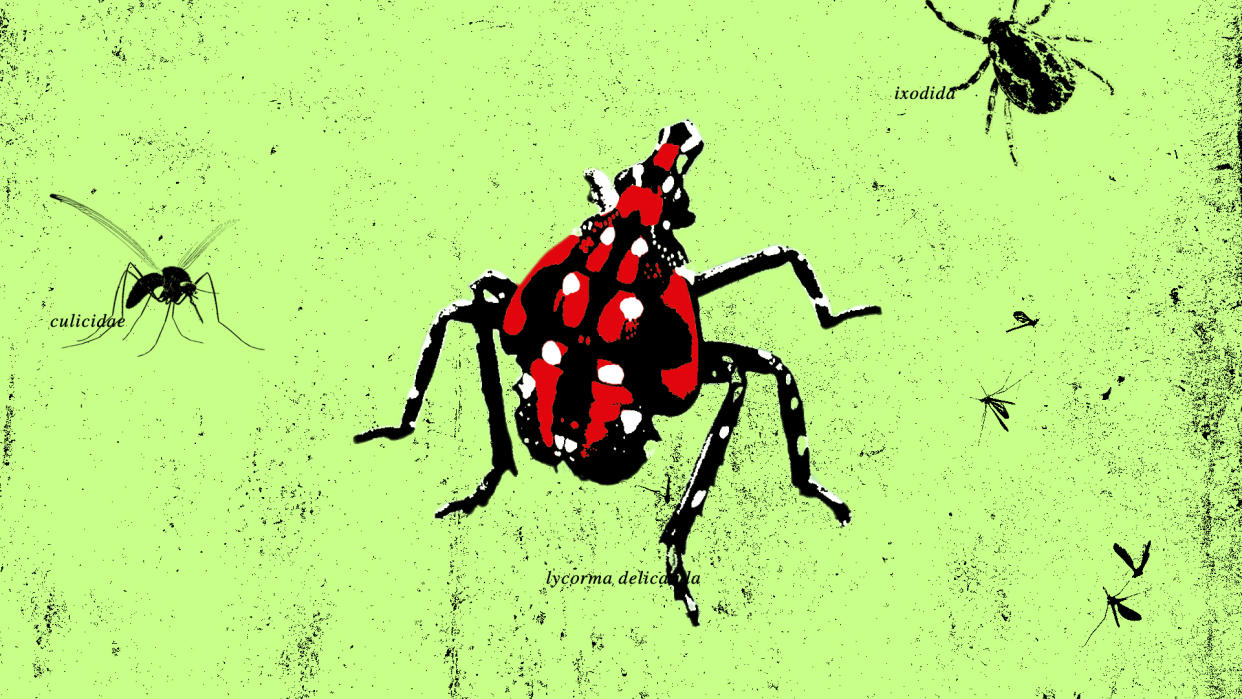Here are some of the weirdest things that happened in 2023

From UFOs and flying snakes to smoke from Canadian wildfires bathing U.S. cities in a postapocalyptic glow, 2023 had more than its share of weird news. Here are just some of the strange things that happened this year.
Aaron Rodgers’s injury on his 1st Jets drive

The New York Jets star quarterback tore his achilles tendon just four plays into the season.
On Sept. 12, less than five minutes into Rodgers’s much anticipated debut on “Monday Night Football” — before he had thrown a single completion for the Jets — he was sacked and had to be helped off the field by the training staff. A cart soon took him back to the locker room, stunning the sold-out crowd at MetLife Stadium. It was later determined that Rodgers had sustained an Achilles injury that required surgery, likely ending his season almost before it began.
“The Jets just can’t have nice things,” Yahoo Sports’ Frank Schwab wrote.
The Jets wound up winning that game but struggled with backups, including Zach Wilson, and missed the playoffs again.
Rodgers, who signed a two-year deal with the Jets, had toyed with the idea of trying to play again this season if the Jets were in contention, but he will now set his sights on returning next year.
That Chinese spy balloon floating across the U.S.

A suspected Chinese spy balloon was spotted in the skies over Alaska in late January and hovered above the nation for days before President Biden ordered the U.S. military to shoot it down.
U.S. officials said the balloon was potentially carrying explosives and hazardous material, which factored into Biden’s decision to wait until it had drifted off the coast of Myrtle Beach, S.C., before ordering it shot down, on Feb. 4.
Five days later another unknown object was spotted flying off the remote northern coast of Alaska. Biden ordered it shot down the following day.
According to the White House, the object — roughly the size of a small car — was downed because it was flying at about 40,000 feet and posed a reasonable threat to the safety of civilian flights, not because of any knowledge that it was engaged in surveillance.
Two more UFOs, one over the Yukon Peninsula, the other over Montana, were subsequently shot down by U.S. military jets — or four in just eight days.
In a briefing with reporters, Gen. Glen VanHerck, head of NORAD and U.S. Northern Command, was asked whether he could rule out the possibility they were of extraterrestrial origin.
“I haven’t ruled out anything at this point,” VanHerck said.
Kid Rock’s beef with Bud Light

The country-rock performer was among those apparently triggered by the beer giant's decision to partner with Dylan Mulvaney, a transgender activist and influencer.
“Let me say something to all of you and be as clear and concise as possible: “F*** Bud Light. And f*** Anheuser-Busch,” Rock said in a short clip posted in April in which he shot cans of Bud Light with an assault-style rifle. The clip went on to be viewed more than 50 million times.
Mulvaney, a transgender actress, activist and influencer, had earlier posted a video to Instagram promoting the domestic beer. Right-wing media figures, including some on Fox News, quickly called for a boycott of Bud Light and Anheuser-Busch, the St. Louis-based company that produces over 100 beer brands, including Budweiser, Busch, Michelob Ultra and Stella Artois.
Anheuser-Busch initially defended its collaboration with Mulvaney. But sales of Bud Light plummeted, executives stepped down and the company tried to distance itself from Mulvaney — prompting a backlash from members of the LGBTQ community.
Rock, who owns a Nashville bar that continued to serve Bud Light despite his protest, ultimately dropped his boycott.
“Do I want to hold their head underwater and drown them because they made a mistake? No,” Rock told Tucker Carlson earlier this month. “I think they got the message.”
Rep. Lauren Boebert’s raucous night out

The Colorado Republican and far-right provocateur was tossed from a Denver performance of the musical “Beetlejuice” for allegedly vaping during the show.
Boebert and a male companion were removed from the city-owned Buell Theatre following an intermission. According to the Denver Post, fellow theatergoers said the congresswoman had been vaping, singing and generally “causing a disturbance” before she was booted from the show.
Surveillance video published by NBC Denver affiliate 9NEWS showed Boebert exchange words with and flip off a theater employee while being escorted out of the building.
A subsequent video showed vaping in front of a pregnant woman who claimed that the lawmaker refused to stop doing so when asked. A third video showed Boebert and her companion groping one another during the show.
Her office downplayed the incident. “I can confirm the stunning and salacious rumors,” Boebert’s spokesman Drew Sexton said in a statement. “In her personal time, Congresswoman Lauren Boebert is indeed a supporter of the performing arts (gasp!) and, to the dismay of a select few, enthusiastically enjoyed a weekend performance of ‘Beetlejuice.’”
Gannett’s full-time Taylor Swift reporter

The biggest newspaper chain in the United States hired a full-time reporter to cover the globe-trotting pop star for USA Today and its 200 local affiliates.
Posted in September, the job listing made clear that the stories the Swift reporter would produce would not be fluff. The chosen candidate would be tasked with examining the significant impact Swift has on our culture — and would be paid between $21.63 and $50.87 per hour.
"Swift's fanbase has grown to unprecedented heights, and so has the significance of her music and growing legacy," the job description read.
A month later, Gannett announced that it had found its Swift correspondent: Bryan West, a 35-year-old award-winning journalist from Arizona who explained in his video cover letter for the position that he is a Swiftie. Still, he said, he can report on the artist without bias.
That the company chose a man and a fan did not sit well with some critics.
“I don’t know this man, but I feel like I should say that I know *for a fact* that hundreds if not thousands of women applied for this job that involves, you know, reporting on a female musician who writes music about the female experience,” Emily Holshouser, a Southern California-based crime reporter, wrote on X.
America’s hot bug summer

Tick, mosquito and spotted lantern fly outbreaks made people crazy in 2023.
Millions of Americans dealt with a surge of bugs this summer — from spotted lantern flies across the Northeast and aphids in New York City to mosquitoes in Los Angeles.
“If it seems like tick seasons are getting longer and worse, that’s because they are,” Time magazine reported in July.
That is due to climate change, as warmer springs and falls lead to longer seasons for blacklegged ticks — which have spread from the Northeast to 43 states. Subsequent cases of tickborne illnesses such as Lyme disease were up too.
Meanwhile, mosquito season was especially bad in some parts of the country. In Orange County, Calif., for instance, government-run mosquito traps captured three times the average number of mosquitoes, according to the Associated Press. The culprit? California’s heavy rainfall last winter.
While mainly just a nuisance, the blood-sucking flies can carry serious diseases, especially in warmer climates. In recent years, dengue fever, the Zika virus, chikungunya and malaria have been detected in states and territories such as Florida, Hawaii, Texas and Puerto Rico, according to the Centers for Disease Control and Prevention.
The Northeast, meanwhile, became ground zero this summer for a new infestation of spotted lantern flies. These polka-dotted bugs native to Asia feed on and can kill trees, including fruit trees, making them a serious threat to industries such as logging and agriculture. Residents along the eastern seaboard were encouraged to squash any that they saw.
The smoke from Canadian wildfires

Smoke and ash from wildfires burning across Canada bathed U.S. cities and states in unhealthy air.
Back in June, over 120 million people — more than a third of the U.S. population — found themselves under air quality alerts as massive clouds of smoke from Canadian wildfires spread across more than a dozen states.
Residents in cities like Chicago and New York City experienced some of the worst air quality in the world, with hazy skies and the smell of smoke blanketing the Northeast and Midwest in an apocalyptic orange haze. The plumes of smoke even reached Europe.
As people on the East Coast became intimately familiar with the Air Quality Index — a color-coded numerical scale that helps people understand the health risks and exposures to airborne pollutants — experts warned that this could be the new normal, given climate change and Canada’s wooded landscape.
“As long as those fires keep burning up there, that’s going to be a problem for us,” Greg Carbin, forecaster with the National Oceanic and Atmospheric Administration’s Weather Prediction Center, told the Associated Press.
According to the Canadian Interagency Forest Fire Center, there were more than 500 active fires in late June, with more than half considered to be burning out of control as hotter and drier air made conditions ripe for wildfires.
Numerous studies have shown that wildfire smoke can be harmful to human health, causing symptoms ranging from eye and respiratory tract irritation to asthma attacks and heart failure, according to the Environmental Protection Agency. People in affected areas and those with respiratory conditions were urged to limit outdoor activities and stay indoors.
The submersible disaster

A tourist submersible disappeared while exploring the Titanic shipwreck, triggering a massive international search and rescue mission that captured the world’s attention in June.
U.S. officials concluded that the vessel experienced a “catastrophic implosion” that probably killed all five people on board. The victims were identified as French explorer Paul-Henri Nargeolet, OceanGate CEO Stockton Rush, British billionaire and explorer Hamish Harding, Pakistani businessman Shahzada Dawood, and his 19-year-old son, Suleman.
It’s not clear exactly when or where the implosion occurred, or what caused it.
The Polar Prince, a Canadian research vessel and support ship, lost contact with the Titan, operated by OceanGate, a private exploration company based in Everett, Wash., approximately 900 miles east of Cape Cod, about an hour and 45 minutes after launch.
A senior military official later said the U.S. Navy detected an “anomaly” that was likely to have been the Titan’s fatal implosion.
The tragedy wasn’t without controversy. James Cameron, who directed the movie “Titanic” and has made 33 visits to the wreckage of the luxury liner, blamed the ship’s carbon-fiber hull for the implosion in a series of interviews, calling it “completely inappropriate for a vessel that sees external pressure.”
This crazy true story

A Texas woman said a snake fell out of the sky and onto her arm — then, a hawk swooped in and attacked it.
Talk about a truly weird news story: In late July, Peggy Jones was mowing her lawn in Silbee, Texas, when a snake fell out of the sky and wrapped its body around her arm. Then a hawk immediately swooped in, CBS News reported, and a National Geographic-style brawl ensued.
“The hawk grabbed the snake that was wrapped around my arm and pulled it like he was going to carry it away,” she recalled. “And when he did, it flung my arm up. The hawk was carrying my arm and the snake with it.”
After several agonizing minutes, the hawk managed to pull the snake off Jones, whose arm was bruised and bloodied by the hawk’s talons. She may also have been bitten by the snake, though she’s not sure she was.
Her husband took her to the hospital where she was treated for “cuts, abrasions, scratches and severe bruising,” CBS News said.
Jones was given antibiotics and stayed up all night monitoring her wounds.
“Not that I could’ve slept anyway,” she said.

